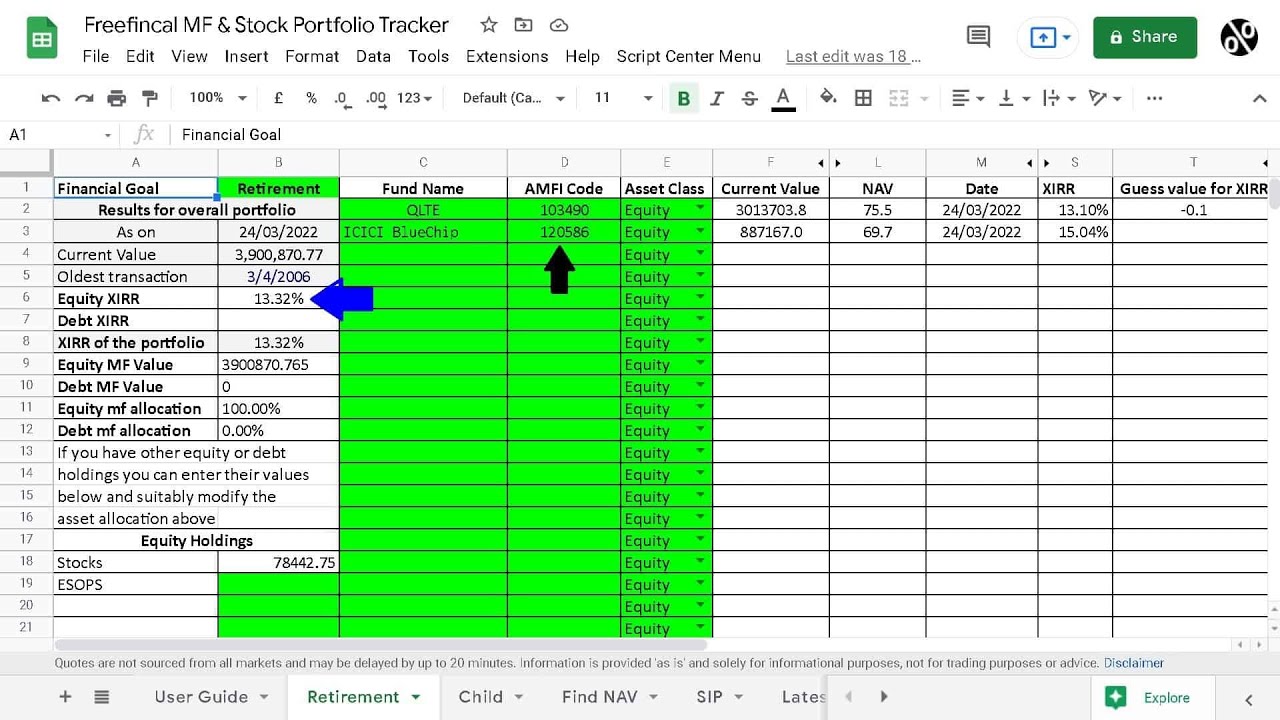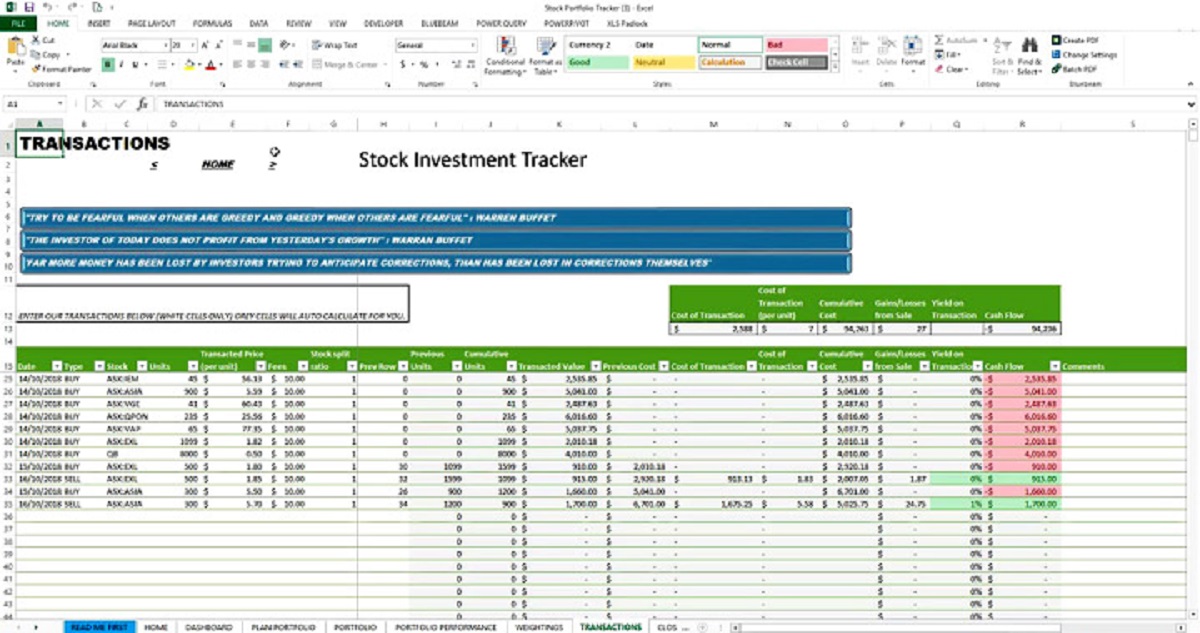Introduction
Welcome to the exciting world of investment tracking! Whether you are a seasoned investor or just starting out, keeping tabs on your investments is crucial for success. By regularly monitoring and analyzing your portfolio, you can make informed decisions and maximize your returns.
Tracking your investments allows you to gain insights into how your assets are performing, identify trends, and adjust your strategy accordingly. It enables you to keep a record of your investments, including stocks, bonds, mutual funds, real estate, and more. With the right tools and techniques, you can simplify the process and stay on top of your financial goals.
In this guide, we will walk you through the step-by-step process of tracking your investments effectively. From setting up a tracking system to analyzing your performance, we’ve got you covered.
Before we dive into the details, it’s essential to understand that tracking your investments requires discipline and commitment. It may seem daunting at first, but the benefits outweigh the initial effort. You’ll gain valuable insights into your investment performance, identify potential risks, and seize opportunities for growth.
So, whether you’re managing a small portfolio or a diverse range of investments, let’s embark on this investment tracking journey together. By the end of this guide, you’ll have the tools and knowledge to confidently monitor and analyze your investments
Step 1: Determine your investment goals
Before you begin tracking your investments, it’s important to have a clear understanding of your investment goals. This step will help you align your tracking efforts with your financial objectives and set a roadmap for success.
Start by asking yourself what you want to achieve through your investments. Are you investing for retirement, purchasing a home, funding your child’s education, or simply trying to grow your wealth?
Next, consider your time horizon. Are you investing for the short-term or the long-term? This will influence the type of investments you choose and the level of risk you are willing to take.
Additionally, think about your risk tolerance. Are you comfortable with the ups and downs of the market, or do you prefer a more conservative approach?
Once you have a clear vision of your investment goals, it’s important to quantify them. Set specific financial targets and timeframes that are achievable and realistic.
For example, you may aim to achieve a certain percentage of return on your investments within a five-year period. Having measurable goals will not only keep you motivated but also provide benchmarks for evaluating your progress.
Remember, your investment goals may evolve over time as your circumstances change. It’s essential to revisit and reassess them periodically to ensure they are still in line with your financial aspirations.
By determining your investment goals upfront, you’ll have a clear direction and purpose for tracking your investments. This will help you make informed decisions and stay focused on your long-term objectives.
Step 2: Choose the right investment tracking tool
Now that you have established your investment goals, it’s time to select the right tool to track your investments effectively. With numerous options available, finding a tool that suits your needs and preferences is essential.
One popular option is using online investment tracking platforms or portfolio management platforms. These platforms offer a range of features, including real-time tracking, performance analysis, and customizable reports.
When choosing a tracking tool, consider factors such as ease of use, compatibility with your investment types, and the ability to sync with your brokerage accounts. Look for platforms that provide comprehensive analytics, such as charts and graphs, to help you visualize your investment performance.
If you prefer a more hands-on approach, you can create a personalized tracking spreadsheet using software like Microsoft Excel or Google Sheets. This allows you to have full control over your tracking system and customize it to your specific needs.
Whichever tool you choose, ensure that it provides features such as automatic data updates, notifications for portfolio changes, and the ability to track multiple investments simultaneously.
Additionally, consider the level of security offered by the tracking tool. Look for platforms that utilize encryption and two-factor authentication to protect your sensitive financial data.
Remember, the key is to find a tracking tool that aligns with your investment goals and provides a seamless user experience. Take your time to research and compare different options before making a decision.
Once you have selected the right investment tracking tool, the next step is to set up your tracking system and input your investment information, which we will discuss in the next steps.
Step 3: Set up your tracking system
With the right investment tracking tool in hand, it’s time to set up your tracking system to ensure accurate and efficient monitoring of your investments.
First, organize your investment information. Gather all the necessary documents, such as brokerage statements, transaction records, and dividend statements.
Next, categorize your investments. Create different categories based on asset types, such as stocks, bonds, mutual funds, and real estate. Within each category, you can further organize them by specific investments.
Once you have categorized your investments, it’s time to input the relevant details into your tracking tool or spreadsheet. Include information such as the name of the investment, the quantity or number of shares, the purchase date, and the purchase price.
If you have multiple investments, it may be helpful to create a separate sheet or tab for each category to ensure clarity and organization.
Consider adding additional columns or fields to include details such as dividends received, transaction fees, and any relevant notes or comments.
To keep your tracking system up to date, set a regular schedule for updating your investment information. This could be weekly, monthly, or quarterly, depending on your preference and the frequency of your investment activity.
In addition to inputting your initial investment details, make sure to update your tracking system whenever there are changes to your investments. This includes buying or selling assets, receiving dividends, or any other significant events.
By setting up a comprehensive and well-organized tracking system, you will have a clear overview of your investments and be able to monitor their performance accurately and efficiently.
In the next step, we will explore how to monitor your investments regularly to stay informed and make informed decisions.
Step 4: Input your investment information
Once you have set up your tracking system, it’s time to input your investment information accurately. This step is essential to ensure that your tracking tool or spreadsheet reflects the most up-to-date and accurate information about your investments.
Start by gathering all the necessary investment-related documentation, such as brokerage statements, trade confirmations, and dividend statements. These documents will provide you with the details you need to input into your tracking system.
For each investment, enter the relevant information into your tracking tool or spreadsheet. Include details such as the name of the investment, the number of shares or quantity, the purchase date, and the purchase price.
In addition to the initial investment information, make sure to update your tracking system whenever there are any changes or transactions related to your investments. This may include buying or selling assets, receiving dividends, or reinvesting dividends.
It’s crucial to be diligent and accurate when inputting your investment information. Double-check the numbers and verify that all the data is entered correctly. This will ensure that your tracking system provides you with reliable and precise information about your investments.
It may be helpful to establish a routine for updating your investment information on a regular basis. Set a schedule that works for you, whether it’s daily, weekly, or monthly. By staying consistent with updating your tracking system, you’ll have a comprehensive record of your investment activity.
Remember, the accuracy of your investment information is vital for effective tracking. By taking the time to input and update your investment details diligently, you’ll have a clear and reliable overview of your portfolio.
In the next step, we will discuss how to monitor your investments regularly to stay informed about their performance.
Step 5: Monitor your investments regularly
Once you have inputted your investment information into your tracking system, it’s crucial to monitor your investments regularly. This step will help you stay informed about the performance of your portfolio and make informed decisions as needed.
Set a schedule for reviewing your investments. This could be weekly, monthly, or quarterly, depending on your investment strategy and the level of activity in your portfolio.
During your monitoring sessions, pay attention to key indicators such as the overall performance of your investments, any changes in market conditions, and any significant news or events that may impact your portfolio.
Utilize the features of your tracking tool or spreadsheet to analyze the performance of individual investments as well as your portfolio as a whole. Look for trends, patterns, and deviations from your investment goals.
Consider using charts, graphs, and other visual representations to get a clearer picture of your investment performance. These visual aids can help you identify areas where adjustments may be necessary.
Be mindful of any changes in your investment strategy or risk tolerance. As your financial goals and circumstances evolve, you may need to make adjustments to your investments. Regular monitoring will help you identify areas where changes are needed.
While it’s important to monitor your investments regularly, avoid becoming too consumed by short-term fluctuations or daily market movements. Long-term investment success is often a result of staying focused on your financial goals and making informed decisions based on sound analysis.
Take note of any changes in your investments, such as changes in market conditions, dividend payouts, or any significant events related to the companies or sectors in which you have invested.
By monitoring your investments regularly, you’ll be better equipped to make timely adjustments to your portfolio and take advantage of opportunities for growth.
In the next step, we will discuss how to analyze your investment performance to gain deeper insights into your portfolio.
Step 6: Analyze your investment performance
Analyzing your investment performance is a crucial step in tracking your investments effectively. By evaluating the performance of your investments, you can gain valuable insights and make informed decisions to optimize your portfolio.
Start by reviewing the overall performance of your portfolio. Look at the returns you have achieved in comparison to your investment goals. Identify areas where your portfolio has outperformed or underperformed.
Consider calculating important financial metrics such as the compound annual growth rate (CAGR) or the return on investment (ROI) to determine the average annual return you have achieved.
In addition to assessing the overall performance, analyze the performance of individual investments within your portfolio. Look for investments that have performed exceptionally well or significantly underperformed.
Dig deeper into the reasons behind the performance of your investments. Consider factors such as market conditions, economic trends, industry developments, and the performance of individual companies.
Identify any patterns or trends that can help you make better investment decisions in the future. For example, you may notice that certain sectors tend to perform well during specific periods, or that certain types of investments consistently outperform others.
Compare your portfolio performance to relevant benchmarks, such as stock market indices or mutual fund performance. This will give you a broader perspective on how your investments have fared in comparison to the broader market.
Take note of any adjustments or changes you have made to your portfolio and evaluate their impact on performance. Assess whether those adjustments have had the desired effect or if further adjustments are needed.
As you analyze your investment performance, be sure to consider your risk tolerance and investment objectives. Remember that investments inherently come with a certain level of risk, and it’s important to strike a balance between risk and potential returns.
Regularly analyzing your investment performance will help you identify areas for improvement, capitalize on successful investment strategies, and make informed decisions for the future.
In the final step, we will discuss how to make adjustments to your portfolio as necessary based on your performance analysis.
Step 7: Make adjustments as necessary
Once you have analyzed the performance of your investments, it’s time to make adjustments to your portfolio as necessary. This step allows you to capitalize on opportunities, manage risks, and ensure that your investments align with your changing financial goals and market conditions.
Based on your performance analysis, identify investments that are consistently underperforming or not meeting your expectations. Consider whether it’s wise to continue holding onto these investments or if it’s time to sell and reallocate your resources elsewhere.
On the other hand, if certain investments have shown strong performance and are exceeding your expectations, you may want to consider increasing your exposure to those assets. This can help you maximize your returns and potentially benefit from the continued growth of those investments.
Consider your risk tolerance and reassess your asset allocation. If you find that you are more risk-averse than initially anticipated, you may want to shift towards more conservative investments. Conversely, if you have a higher risk tolerance, you might want to allocate a larger portion of your portfolio to higher-risk assets.
Keep in mind that the investment landscape is constantly evolving, and market conditions can fluctuate. Stay informed about economic trends, industry developments, and any other factors that may impact your investments.
When making adjustments, be mindful of transaction costs and tax implications. Selling or buying investments may incur fees, and it’s crucial to assess whether these costs outweigh the potential benefits of the adjustment.
It’s important to note that making adjustments to your investment portfolio should be done strategically and not based solely on short-term market fluctuations. Avoid making impulsive decisions based on emotional reactions to market movements. Instead, take a disciplined approach based on thorough analysis and research.
Periodically review and adjust your investment strategy as needed. Your financial goals, risk tolerance, and market conditions may change over time, and it’s crucial to ensure that your investments remain aligned with your evolving needs.
Remember to keep detailed records of any adjustments you make to your portfolio. This will help you track your decision-making process and assess the impact of your adjustments on the performance of your investments in the long run.
By regularly reassessing and making adjustments as necessary, you can optimize your portfolio and enhance your chances of achieving your investment goals.
With these steps, you now have a solid foundation for effectively tracking and managing your investments. By following these guidelines and staying proactive in monitoring and adjusting your portfolio, you’ll be well on your way to financial success.
Conclusion
Congratulations on completing the journey of learning how to track your investments effectively! By following the steps outlined in this guide, you have gained the knowledge and tools to monitor, analyze, and adjust your portfolio in a strategic manner.
Investment tracking is an ongoing process that requires discipline, regular monitoring, and the ability to adapt to changing market conditions. Remember to stay focused on your investment goals and make informed decisions based on thorough analysis rather than reacting to short-term market fluctuations.
Start by determining your investment goals and aligning them with your risk tolerance and time horizon. Select the right investment tracking tool that suits your needs and preferences. Set up a comprehensive tracking system, input your investment information diligently, and monitor your investments regularly.
Take the time to analyze your investment performance, comparing it to relevant benchmarks and identifying areas for improvement. Finally, make adjustments as necessary based on your analysis and market conditions, ensuring that your portfolio remains aligned with your financial goals.
Remember that investing involves risks, and there are no guaranteed outcomes. Be sure to educate yourself and stay informed about market trends, economic indicators, and industry developments that may impact your investments.
By having a clear understanding of your investment goals, tracking your investments diligently, and making informed adjustments, you are setting yourself up for long-term investment success.
Now, go forth with confidence and put your newfound knowledge into practice. Track your investments, seize opportunities, and navigate the ever-changing investment landscape with ease. Good luck on your investment journey!

























